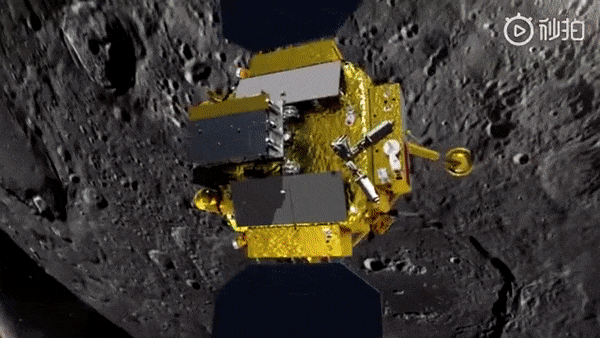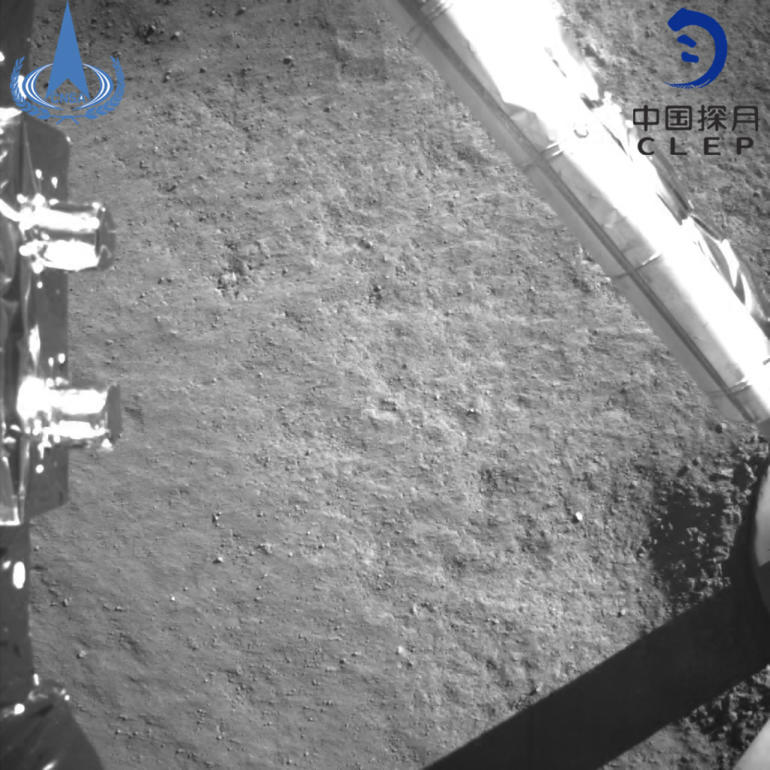People have drawn inspiration from the moon for many millennia, but the reality of this heavenly body have gotten a lot closer.
On Wednesday, China’s Chang’e 4, which launched from Xichang Satellite Launch Center in early December, became the first ever probe to soft-land on the far side of the moon.
China Central Television reports the lunar explorer Chang’e 4 had touched down at 10:26 a.m., BJT.

Animation depicting the landing process for the Chang’e-4. (CREDIT: China Academy of Space Technology)
Among China’s scientific goals for Chang’e 4 are expanded astronomical observation using low frequency radio; mineral collection and analysis; neutron atom and radiation analysis; and even delivering a mini-ecosystem of potatoes, mustard seeds, and silkworms to the surface of the Moon.

An image captured during the landing process of Chang’e-4 lunar probe /CNSA Photo

An image captured during the landing process of Chang’e-4 lunar probe /CNSA Photo
Learn more about the Chang’e-4 mission
China’s Chang’e 4 Moon mission adds another first to the history of lunar exploration: The FAR SIDE. CGTN’s Joshua Barlow explains the mission.
After achieving orbit Sunday morning, Chang’e 4 landed Tuesday in the southern section of the Von Kármán crater, part of the South-Pole Aitken (SPA) basin. Compared to other, more rocky areas of the far side, Von Karman provides relatively flat surfaces for the probe and its package to land.
Theodore Von Kármán, for whom the crater was named, was an instructor and mentor to Qian Xuesen when he studied at Massachusetts Institute of Technology (MIT) and California Institute of Technology (Caltech) in the 1950s. Qian is considered by many to be the “Father of Chinese Rocketry.”

Oblique view of Von Kármán, on the far side of the moon, facing west, imaged by the Lunar Orbiter 5 spacecraft in 1967. (CREDIT: Lunar and Planetary Institute, Lunar Orbiter Photo Gallery)

A preliminary monochrome mosaic of the moon from the Lunar Reconnaissance Orbiter (LRO) Wide Angle Camera (WAC), centered in the middle of the South Pole-Aitken basin. (CREDIT: NASA/GSFC/Arizona State University)
Contrary to common belief, the far side of the Moon is not the same as the dark side. The Moon is tidally locked, which means one side is always facing Earth… While the other side always faces away. This is the far side, which we cannot see directly from Earth.
To begin exploring this uncharted area, the first key challenge was to guarantee communication with controllers on Earth.
Since the moon itself blocks direct radio transmission, China launched Chang’e-4’s relay satellite, Queqiao or Magpie Bridge earlier this year. It’s role is to “bounce” the probe’s signal back to Earth. It has since entered Halo orbit around the moon, about 400,000km (250,000 miles) from Earth, where it will serve as a perfect communication link.

An animation showing Chang’e-4 in lunar orbit and communicating with the Queqiao relay satellite at the second Earth-Moon Lagrange point. (CREDIT: CAST)
The China National Space Administration (CNSA) in Beijing had to alter the probe’s orbit twice since Sunday, while they also tested communications between the probe and the Queqiao satellite. According to CNSA, the lunar rover’s imaging and GPS tools are prepared for operation.
With Chang’e 3 in 2013, China became the first nation to land a probe on the moon since 1976. Unfortunately, the Yutu, or Jade Rabbit rover lost mobility within two months after landing. The CNSA stated that lessons learned from that first probe drastically improved technology designed for Chang’e 4.
Chang’e 4 marks the completion of stage two in the Chinese Lunar Exploration Plan (CLEP).
In 2020, China plans to complete a third and final phase with Chang’e 5. In that mission, the lunar lander and rover will return to Earth after collecting samples and completing its scientific mission on the moon.
More:
 CGTN America
CGTN America
 The moon’s far side, as photographed by China’s Chang’e 5 T1 in 2014, is the target for the Change’e 4 mission. (CREDIT: Chinese Academy of Sciences)
The moon’s far side, as photographed by China’s Chang’e 5 T1 in 2014, is the target for the Change’e 4 mission. (CREDIT: Chinese Academy of Sciences)

